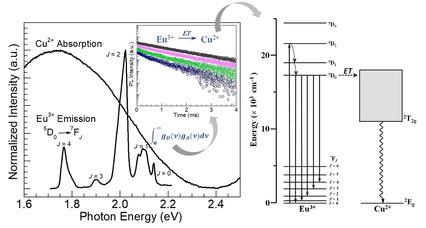当前位置:
X-MOL 学术
›
ChemPhysChem
›
论文详情
Our official English website, www.x-mol.net, welcomes your
feedback! (Note: you will need to create a separate account there.)
Optical Spectroscopy and Excited-State Dynamics of Eu3+ -Doped Bismuth Borate Glasses Containing CuO.
ChemPhysChem ( IF 2.3 ) Pub Date : 2020-07-06 , DOI: 10.1002/cphc.202000396 José A Jiménez 1 , Brien Darley 1
ChemPhysChem ( IF 2.3 ) Pub Date : 2020-07-06 , DOI: 10.1002/cphc.202000396 José A Jiménez 1 , Brien Darley 1
Affiliation

|
Bismuth borate glasses containing phosphors and luminescent rare‐earths are of interest for applications in light‐emitting devices. Herein, the influence of CuO impurities on red‐emitting Eu3+‐doped bismuth borate glasses of the 25Bi2O3‐15BaO‐10Li2O‐50B2O3 type was investigated by various spectroscopic methods. The glasses were prepared by the melt‐quench technique and characterized by X‐ray diffraction (XRD), Fourier transform‐infrared (FT‐IR) spectroscopy, UV/Vis optical absorption (OA), and photoluminescence (PL) spectroscopy including decay kinetics assessment. The XRD data confirmed the amorphous nature of the glasses whereas FT‐IR spectra indicated the basic structural features of trigonal BO3 units and BO4 tetrahedra. The OA analysis showed that addition of CuO up to 0.5 mol% results in significant growth of the visible Cu2+ absorption band around 715 nm, with slight decrease in the optical band gap energies assessed through Tauc plots. A drastic PL quenching of Eu3+ ions emission was evidenced concurring with the detrimental effect of Cu2+. The assessment of the Eu3+ emission decay curves revealed significant lifetime decrease of the 5D0 emitting state with increasing CuO concentration. An analysis of quenching constants was finally performed comparing results from integrated PL data with the emission decay rates. It is argued that the bismuth borate glass system supports an effective Eu3+→Cu2+ energy transfer (more so than phosphates) in connection with a strong spectral overlap between Eu3+ emission and Cu2+ absorption.
中文翻译:

含CuO的Eu3 +掺杂硼酸铋玻璃的光谱学和激发态动力学。
包含磷光体和发光稀土元素的硼酸铋玻璃在发光设备中的应用很受关注。在此,CuO杂质对25Bi 2 O 3 -15BaO-10Li 2 O-50B 2 O 3的红色发射Eu 3+掺杂的硼酸铋玻璃的影响通过各种光谱方法研究了该类型。这些玻璃是通过熔融淬火技术制备的,并通过X射线衍射(XRD),傅立叶变换红外(FT-IR)光谱,UV / Vis光学吸收(OA)和光致发光(PL)光谱(包括衰减动力学)进行了表征。评定。XRD数据证实了玻璃的非晶态性质,而FT-IR光谱则表明了三角形BO 3单元和BO 4四面体的基本结构特征。OA分析表明,添加最多达0.5 mol%的CuO会导致715 nm附近可见Cu 2+吸收带的显着增长,而通过Tauc图评估的光学带隙能量会略有下降。Eu 3+的PL急剧淬灭离子发射被证明与Cu 2+的有害作用同时存在。Eu 3+发射衰减曲线的评估表明,随着CuO浓度的增加,5 D 0发射态的寿命显着减少。最后,将积分PL数据的结果与发射衰减率进行比较,对淬灭常数进行了分析。有人认为,硼酸铋玻璃体系与Eu 3+发射和Cu 2+吸收之间的强光谱重叠有关,支持有效的Eu 3+ →Cu 2+能量转移(比磷酸盐更多)。
更新日期:2020-07-06
中文翻译:

含CuO的Eu3 +掺杂硼酸铋玻璃的光谱学和激发态动力学。
包含磷光体和发光稀土元素的硼酸铋玻璃在发光设备中的应用很受关注。在此,CuO杂质对25Bi 2 O 3 -15BaO-10Li 2 O-50B 2 O 3的红色发射Eu 3+掺杂的硼酸铋玻璃的影响通过各种光谱方法研究了该类型。这些玻璃是通过熔融淬火技术制备的,并通过X射线衍射(XRD),傅立叶变换红外(FT-IR)光谱,UV / Vis光学吸收(OA)和光致发光(PL)光谱(包括衰减动力学)进行了表征。评定。XRD数据证实了玻璃的非晶态性质,而FT-IR光谱则表明了三角形BO 3单元和BO 4四面体的基本结构特征。OA分析表明,添加最多达0.5 mol%的CuO会导致715 nm附近可见Cu 2+吸收带的显着增长,而通过Tauc图评估的光学带隙能量会略有下降。Eu 3+的PL急剧淬灭离子发射被证明与Cu 2+的有害作用同时存在。Eu 3+发射衰减曲线的评估表明,随着CuO浓度的增加,5 D 0发射态的寿命显着减少。最后,将积分PL数据的结果与发射衰减率进行比较,对淬灭常数进行了分析。有人认为,硼酸铋玻璃体系与Eu 3+发射和Cu 2+吸收之间的强光谱重叠有关,支持有效的Eu 3+ →Cu 2+能量转移(比磷酸盐更多)。











































 京公网安备 11010802027423号
京公网安备 11010802027423号